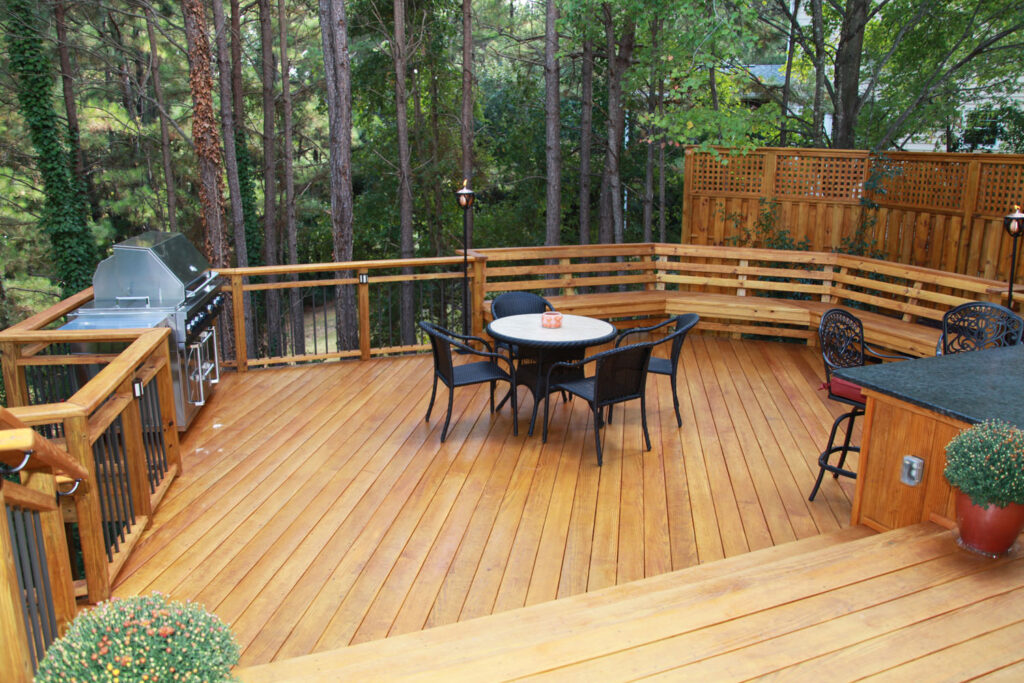الخشب الحقيقي مقابل التزيين المركب أو البلاستيكي
الخشب الحقيقي مقابل
التزيين المركب
في حين أن بعض مالكي المنازل والبنائين يختارون التزيين المركب أو البلاستيكي ، لا يزال الصنوبر الجنوبي المعالج بالضغط هو الخيار الأكثر شيوعا لمجموعة متنوعة من الأسباب.
الجمال والقيمة المضافة والراحة ليست سوى عدد قليل من الأسباب التي تجعل أسطح وشرفات الصنوبر الجنوبي تحظى بشعبية كبيرة ، ناهيك عن أن هذه “الغرف الخارجية” تعمل على توسيع مساحة المعيشة في المنزل للترفيه والاسترخاء في الهواء الطلق.
لكن ألواح التزيين ، سطح المشي على سطح السفينة ، لديها مهمة صعبة. يتطلب التزيين عقابا يوميا قاسيا من الطقس وحركة السير على الأقدام ، وباعتباره الجزء الأكثر وضوحا من سطح السفينة ، يجب أن يفي بتوقعات الملاءمة والتشطيب والمظهر العالية على المدى الطويل.
الخشب هو أفضل خيار بيئي للمشاريع الخارجية
، حيث يمكن أن تتطلب منتجات التزيين الأخرى ما يصل إلى ثمانية أضعاف الطاقة لإنتاجها من الخشب.
الخشب الصلب هو منتج طبيعي ومتجدد ، على عكس المركبات التي تصنع عادة من مواد بترولية مثل البولي إيثيلين أو البولي بروبيلين أو البوليسترين أو البولي فينيل كلوريد.
إذا كنت ترغب في الاختيار بين تزيين الصنوبر الجنوبي أو خيار البلاستيك / المركب ، ففكر في ما يلي:
- الجماليه
- كلف
- المتانه
- الأثر البيئي
- نساء
- صيانة
في النهاية ، يعود الاختيار بين التزيين الخشبي والمركب إلى أولوياتك وتفضيلاتك. إذا كنت تقدر الجمالية الطبيعية وترغب في استثمار الوقت في الصيانة ، فقد يكون التزيين الخشبي هو الخيار الصحيح.

| Question | Real Wood | Composites or Plastics | What are the facts? |
|---|---|---|---|
| Natural Appearance? | Yes | No | There is no substitute for the look and feel of real wood. Wood decking looks warm, natural, and blends beautifully with the landscape. Plastic or plastic composites, even with faux wood grain, still look and feel artificial. |
| Comfortable under foot? | Yes | ? | Wood is a naturally insulating material and does not conduct heat or cold like metal or plastic. In direct sun, some plastic or composite decking can become much hotter than wood, hot enough to burn or blister feet. |
| Safe to use? | Yes | Yes | Pressure-treated wood is safe for people, pets, and the environment. Furthermore, advanced preservative formulations contain no arsenical or chromium compounds while being resistant to decay and termite attack. |
| Renewable? | Yes | No | Wood is the only building material that uses the sun’s energy to renew itself in a continuous cycle. Sustainable forestry practices ensure our supply of homegrown wood will be maintained for future generations. On the other hand, plastics are derived from finite petroleum resources. |
| Earth-friendly? | Yes | No | Manufacturing wood products uses less energy and produces less air and water pollution than other building materials. Manufacturing plastic decking requires more energy to produce than a comparable piece of wood decking. |
| Strong? | Yes | No | Wood can be up to four times stronger than plastic or composite products and possesses up to nine times the stiffness of artificial decking. Wood decking is not affected by heat, which tends to promote creep (sagging) in composites over time. |
| Needs maintenance? | Yes | Yes | Despite claims to the contrary, all decking requires maintenance. Periodic cleaning and application of a water-repellant sealer is all that is needed to keep a wood deck in top shape. A good scrubbing usually removes most stains on wood decking, too. |
| Decay/termite warranty? | Lifetime limited | Limited | Wood preservative manufacturers typically offer a limited lifetime warranty against decay and termite attack in residential use. Plastic or composite deck manufacturers typically offer a limited warranty. |
| Standardized product? | Yes | No | Approved inspection agencies monitor lumber production and pressure-treating facilities. These agencies operate under rigorous protocols to enforce uniform performance and quality standards approved by the American Lumber Standard Committee and/or the American Wood Protection Association. |